( Log In ) Log In is for TREC Teachers & Researchers only
  |
| Steve_Marshall |
 Jun 23 2005, 04:17 PM Jun 23 2005, 04:17 PM
Post
#1
|
 TREC Teacher    Group: TREC Team Posts: 78 Joined: 27-April 05 Member No.: 12 |
Monday 6/20/05 #3
KEEPING UP THE PACE Piston Core Retrieval The busy day continued as the second piston core was retrieved. Encouraged by the first core being almost completely filled (before it bent and some was lost), this one was rigged to be the longest yet at 22 meters (about 70 feet). Watching the core as it was taken out of the water, it was so large that it tended to bend towards the water. After it was brought out and ready to be set down on the deck, its large size caused it to slide back over the water. Seeing it slide and bend, I thought for sure we were going to lose another one. Luckily, however, the crane still had a hold of it, and it was brought back on the ship and secured to the core holders. Although it was successfully retrieved, it was still somewhat of a disappointment as only about half of the 22 meters was filled with sediment. Although it did not reach its maximum, eleven meters of sediment definitely still has value, so the core was sectioned, logged, and labeled just like any other core. Reeling It In  The wince line brings the piston core back to the surface and towards the core holder Iceberg 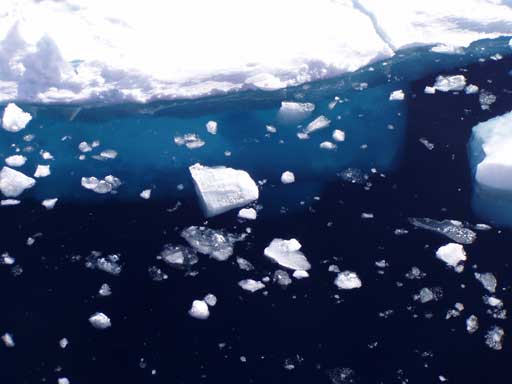 Almost everyone has heard that floating ice has most of it’s volume under water. This picture, taken while watching the coring operation, kind of proves that…It also makes for a cool and colorful picture. Attaching the Crane  Here, the crane line is attached to a moveable line that allows the core to be lifted near the middle of the core, thus allowing it to be brought out of the water Too Long? 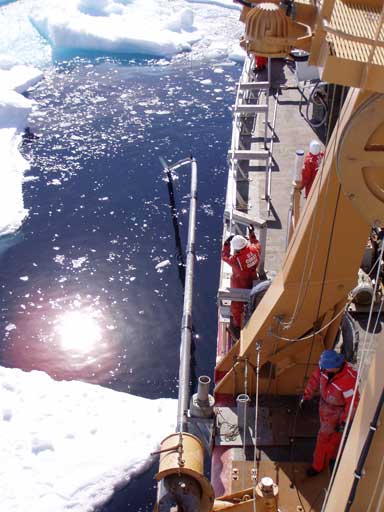 Some of the bending of the core is real, but the bending under the water is an optical illusion caused by the refraction of light by the water. Either way, it was still an anxious moment that brought back memories of the problems with the first core. Safely Out  Despite the bending, the core was finally brought out and put on the ship in its entirety Watching From a Distance  Captain Oliver, at the far right and wearing blue, monitors the coring operation. Dividing Up the Loot  Jens Bischof (left) uses a pipe cutter to divide the core into multiple sections Capping the Core  Once cut, the core sections are capped. Notice the caps are different colors at both ends. This color-coding helps distinguish the top (shallower depth) of the section from the bottom—Something important to know when analyzing and interpreting the core. Plankton Tow After the piston core was retrieved, the plankton tow was up next. This tow would be a vertical plankton tow. With this technique, a fine-mesh net with about a one meter opening is lowered to specified depths. Depths can be of any range, and the net raised and lowered several times within a certain range to sample the amount and type of plankton that live at those various depths. How is a specific range sampled? After raising and lowering the net within the specified range, a weight, called a messenger, is fastened to the line holding the plankton net and then released. The weight travels along the line, and when it hits a particular spot just before reaching the net, it trips a trigger that causes the net to fold over on itself, thus preventing any other plankton from entering the net at shallower depths as the net is brought back up to the surface. Up From the Depths 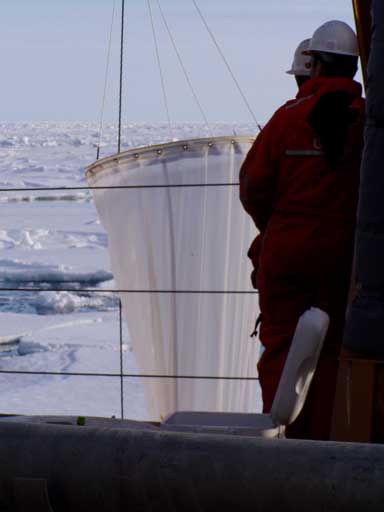 The plankton net being brought back to the surface Big Net for a Little(sized) Catch 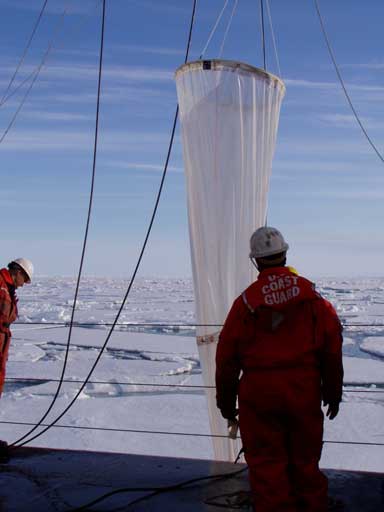 With a crew member in the picture for scale, you can see this is a pretty big net. While the size of the plankton are small, the quantity of them can be very large Brown Water is Good  The brown color of the water just above the bottom of the net indicates it is filled with a large amount of plankton No Plankton Left Behind  The net is rinsed several times to help ensure all the plankton in the net makes it into the bottle CTD Profile Using the day to its fullest, a CTD profiler was sent down after the plankton tows were completed around 11 or 11:30pm. Unfortunately, this procedure had some difficulties. On the first try, something was causing abnormal friction on the line and was also rubbing somewhat against the ship. This meant the CTD instrument had to be brought back to the surface. The friction problem was solved, but on the second try, the problem this time was that the CTD Profiler lost contact with the computer that signals when to open and close the Niskin bottles that are arranged around the profiler. For this reason, only two of the many bottles opened to collect water samples. Some is better than none, however, so this, as well as the conductivity, temperature, and depth readings were still usable data. Besides, as with the piston cores, there would be other opportunities to send down the CTD profiler, so hopefully more complete data can be obtained at another date. Ready for Action 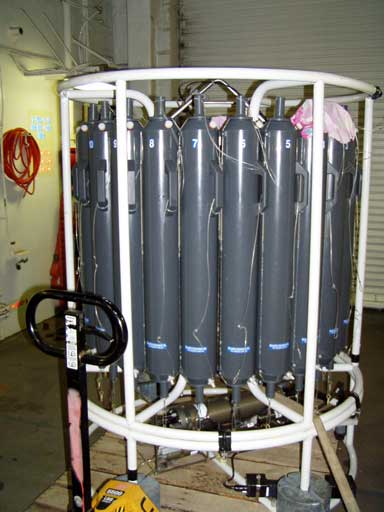 A picture of the CTD profiler that is used to collect data such as salinity, temperature, density, and depth of ocean water at various locations. Finishing after midnight, this was definitely a long and science-filled day. The completion of this work transitioned into the next day, June 21, which happens to be the “longest day” of the year. It seemed appropriate, then, that today was such a busy day, and tomorrow would be even busier. |
| Ute_Kaden |
 Jun 24 2005, 03:47 AM Jun 24 2005, 03:47 AM
Post
#2
|
 TREC Teacher    Group: TREC Team Posts: 203 Joined: 27-April 05 Member No.: 10 |
Hi Steve,
Thank you for the great Healy reports. Our 8 year old son, Michael, absolutely loves the Polar Bear photos , story and your family picture with the baby My husband enjoys the technical stuff about drilling. He worked 10 years underground, Uranium mining, as a mining engineer and would love to support the drilling team. So, if they ever need a hand for coring at a science mission let him know. He absolutely loves heavy machinery, drilling etc. I am slowly getting ready for leg two of HOTRAX. Steve, you are doing a great job reporting for leg one. I will try my best to follow your foot steps during leg two. PS Hopefully San Antonio will win the Basketball game tonight! Ute |
| Ute_Kaden |
 Jun 24 2005, 04:00 AM Jun 24 2005, 04:00 AM
Post
#3
|
 TREC Teacher    Group: TREC Team Posts: 203 Joined: 27-April 05 Member No.: 10 |
San Antonio won 81-74 againest Detroit.
ute |
| Steve_Marshall |
 Jun 25 2005, 05:09 AM Jun 25 2005, 05:09 AM
Post
#4
|
 TREC Teacher    Group: TREC Team Posts: 78 Joined: 27-April 05 Member No.: 12 |
Thanks for the comments, Ute. I'm glad your family has enjoyed different parts of the stories. I'm sure you will do well, if not better with your reporting. I look forward to following it. I've already told some of the crew how much they'll enjoy having you along!
You may also like to know that we have even been able to get some satellite tv while on the ship, so we were able to see the basketball game! Steve |
  |
1 User(s) are reading this topic (1 Guests and 0 Anonymous Users)
0 Members:

|
NSF Acknowledgment & Disclaimer | Time is now: 30th October 2024 - 09:27 PM |
Invision Power Board
v2.1.7 © 2024 IPS, Inc.








